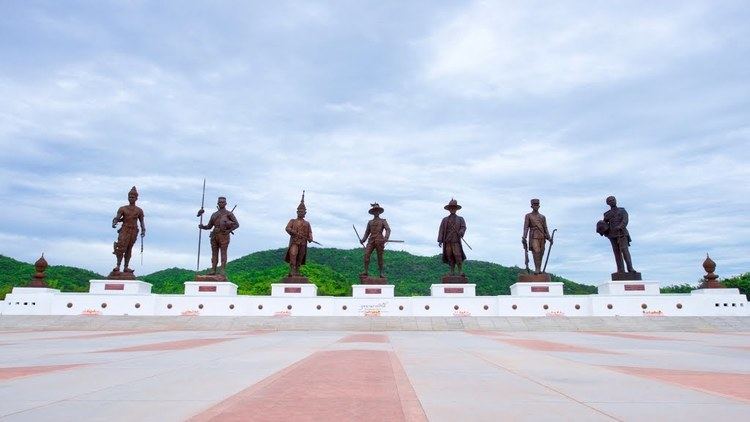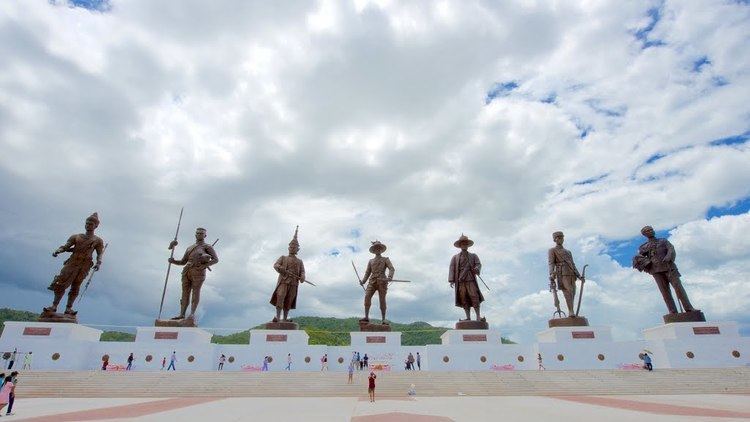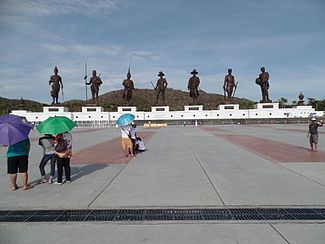 | ||
Similar Cicada Market (ซิเคด้า มา, Vana Nava Hua Hin Water Ju, Mrigadayavan Palace, Pa Sak Jolasid Dam, Three King's Monument | ||
Rajabhakti park 4k
Rajabhakti Park (Thai: อุทยานราชภักดิ์; rtgs: Utthayan Ratchaphak) is a historically themed park honouring past Thai kings from the Sukhothai period to the current royal house of Chakri. It is in Hua Hin, Prachuap Khiri Khan Province, Thailand. It was built by the Royal Thai Army, on Thai Army property, with approximately one billion baht (US$28 million) in funds donated by the public and private sectors. Bhumibol Adulyadej gave the historical park the name "Rajabhakti Park", which means "the park that has been built with people's loyalty to the monarchs". The park occupies an area of 222 rai (355,200 m2 or 36 ha).
Contents

Rajabhakti park
Background

The Rajabhakti Park project was launched as a Royal Thai Army (RTA) initiative by Gen Udomdej Sitabutr when he was the army chief prior to his retirement at the end of September 2015. The Rajabhakti Park Foundation was established to raise funds for the project and to manage it.
Crown Prince Maha Vajiralongkorn, accompanied by his daughter, Princess Bajrakitiyabha, presided over the park's opening ceremonies on 26 September 2015.
Park layout

The park consists of three distinct areas. The first, covering an area of five rai (8,000 m2)), is dominated by the statues of seven notable Thai kings. They are King Ram Khamhaeng (reigned 1279-1298) of the Sukhothai period, King Naresuan (1590-1605) and King Narai (1656-1688) of the Ayutthaya period, King Taksin (1767-1782) of the Thonburi period, and King Rama I (1782-1809), King Mongkut (1851-1868), and King Chulalongkorn (1868-1910) of the Rattanakosin period. Each statue is made of bronze, with an average height of 13.9 meters. They were designed by Thailand's Fine Arts Department. Casting of the statues and construction of the multi-purpose plaza took 10 months, from November 2014 to August 2015. There are plans to add statues of two additional kings in the future.
The base of the statues is 134 m long, 43 m wide, and 8 m high. It houses the park's second component, a museum of Thai history, focusing in particular on the biographies and achievements of the seven kings on display.
The park's large plaza of 91 rai (145,600 m2), is to be used by the Royal Thai Armed Forces for parades, ceremonies welcoming foreign dignitaries, and other special events. The park's peripheral area of 126 rai (201,600 m2) consists of the surrounding landscape and support facilities.
Controversy
In early-November 2015, anonymous Royal Thai Army officials complained to the Thai media about allegedly dodgy dealings related to park funding and procurement, followed by official denial that any public funding was involved. Of concern were seemingly high prices for land, equipment, and construction. There were also rumours of a middleman, later identified as Watcharapong Radomsittipat, who cited his connection to "people in authority" to demand commission fees from the owners of the foundries contracted to fabricate the statues. He was said to have demanded 10 percent kickbacks from each of the foundries commissioned to cast the bronze statues, reported to cost about 40 million baht (US$1.1 million) each. What followed was a deluge of stories about the park and questioning official efforts to derail the controversy. "The [park] has been a public relations disaster for the junta, which said cleaning up corruption was one of its major reasons for seizing power."
Allegations
What was alleged in the Thai press focused primarily on the substantial kickbacks solicited for foundry contracts, but soon other shady dealings were alleged:
